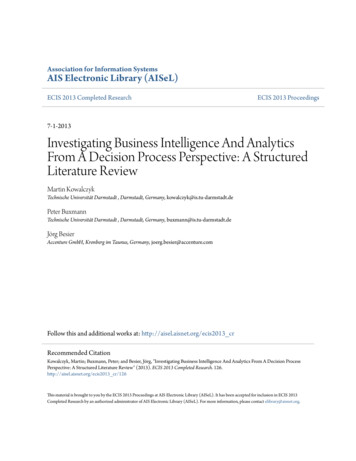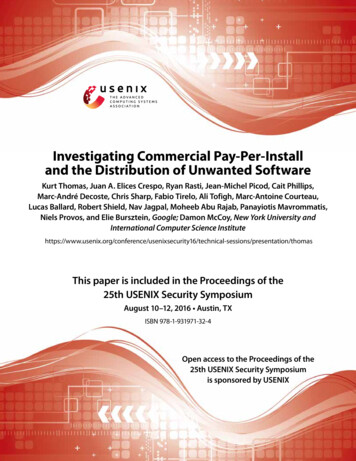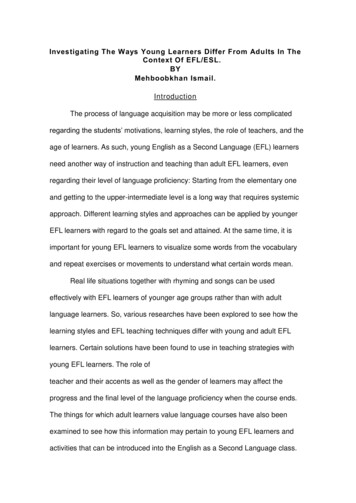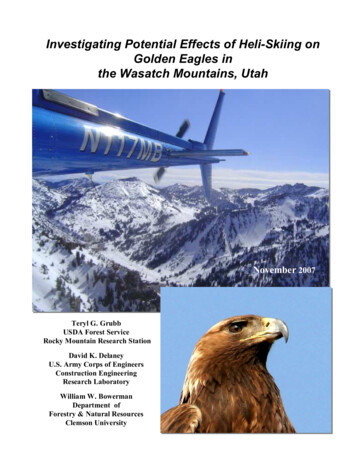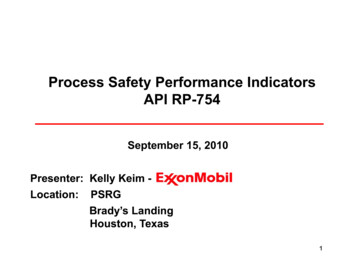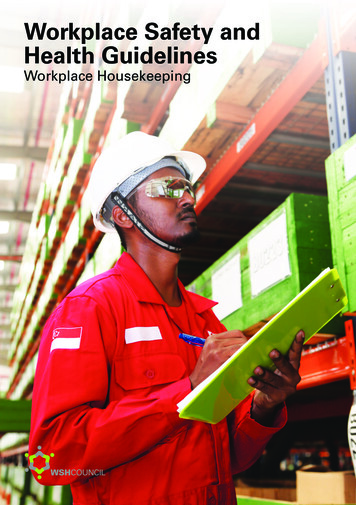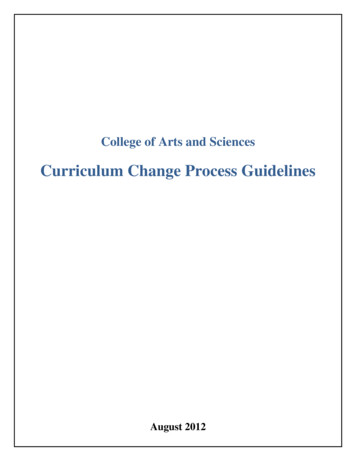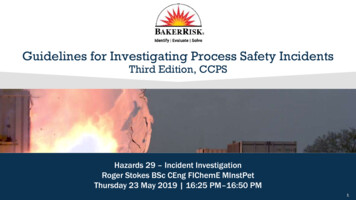
Transcription
Guidelines for Investigating Process Safety IncidentsThird Edition, CCPSHazards 29 – Incident InvestigationRoger Stokes BSc CEng FIChemE MInstPetThursday 23 May 2019 16:25 PM–16:50 PM1
About CCPS Center for Chemical Process Safety March 1985, in response to Bhopal, AIChE formed CCPS withseventeen charter member companies. A collaborative effort to eliminate catastrophic process incidents byadvancing state of the art technology and management practices, servingas the premier resource for information on process safety, supportingprocess safety in engineering, and promoting process safety as a keyindustry value Now over 100 member companies including most of the world’s leadingchemical, petroleum, pharmaceutical and related manufacturingcompanies. Over 100 books and productsHazards 29 CCPS Incident Investigation Book 3rd Edition 23 May 2019 16:25–16:502
Evolution20192003Hazards 29 CCPS Incident Investigation Book 3rd Edition 23 May 2019 16:25–16:503
Acknowledgements – CCPS & Subcommittee Dan Sliva – CCPS Staff LiaisonJerry ForestMichael BroadribbLaurie BrownChonai CheungEddie DaltonCarolina Del DinScott GuinnChristopher HeadenKathleen KasMark ParadiesNestor ParaliticciCelanese (Chair)BakerRiskEastmanContra Costa CountyBASFPSRGChevron CorporationCargillDow Chemical CompanySystem Improvements Inc.AndeavorMuddassir PenkarMorgan ReedMeg ReeseMarc RothschildJoy ShahDan SlivaBob StankovichLee Vanden HeuvelTerry WaldropScott WallaceDella WongEvonik Canada Inc.ExponentOccidental Chemical Corp.DuPontReliance Industries LtdCCPS Staff AdvisorEli LillyABS ConsultingAIGOlinCanadian Natural ResourcesHazards 29 CCPS Incident Investigation Book 3rd Edition 23 May 2019 16:25–16:504
Acknowledgements – Peer ReviewersAmy BreathatSteven D. EmersonPatrick FortuneWalter L. FrankBarry GuilloryJerry L. JonesGerald A. KingSusan M. LeeWilliam (Bill) D. MosierMike MunsilPamela NelsonKatherine PearsonS. Gill SigmonNOVA Chemicals CorporationEmerson AnalysisSuncor EnergyFrank Risk SolutionsLouisiana State UniversityCFEISBC GlobalArmstrong Teasdale LLPAndeavorSyngenta Crop Protection, LLCPSRGSolvay GroupBP AmericasAdvanSixHazards 29 CCPS Incident Investigation Book 3rd Edition 23 May 2019 16:25–16:505
BakerRisk Project TeamQuentin BakerMichael BroadribbCheryl GroundsThomas RodanteHazards 29 CCPS Incident Investigation Book 3rd Edition 23 May 2019 16:25–16:50Roger Stokes6
Major Process Safety Incidents since 2003 2003 – Repsol Puertollano Refinery Explosion2004 – Sonatrach Skikda, Algeria Explosion2005 – BP Texas City Explosion2005 – HOSL Buncefield Explosion2008 – Alon Refinery Explosion2009 – Caribbean Petroleum Explosion2010 – BP Macondo/ Deepwater Horizon2011 – TEPCO Fukushima DaiichiHazards 29 CCPS Incident Investigation Book 3rd Edition 23 May 2019 16:25–16:507
Major Process Safety Incidents since 2003 2012 – Chevron Richmond Refinery Fire2013 – Williams Olefins Explosion / West Fertilizer explosion2014 – Shell Moerdijk Explosion2015 – ExxonMobil Torrance Refinery Explosion2016 – BASF Ludwigshafen ethylene pipeline explosion2017 – Grenfell Tower Fire2018 – Bayernoil, Germany ExplosionHazards 29 CCPS Incident Investigation Book 3rd Edition 23 May 2019 16:25–16:508
Incident Investigation Developments 2003-2019 Methodologies used to investigate process incidentsAttitudes about investigation focus and practicesTechnological developmentsRegulatory agency expectationsLegal rulings regarding admissibility of evidence and expertopinionsHazards 29 CCPS Incident Investigation Book 3rd Edition 23 May 2019 16:25–16:509
Focus of Third Edition Primarily process safety incidents, but concepts equally applicable toother potentially hazardous industries o Manufacturing / miningo Constructiono Transportation Emphasis on investigating near-misses and minor incidentso Had the potential for significant damage /injury and should be considered for a higherlevel of investigation commensurate with the potential consequence. Witness management, evidence analysis, the scientific method, and humanfactors To be more globalo Flexibility in the investigation approach for varying regulatory, industry, cultural, andsituational considerations.Hazards 29 CCPS Incident Investigation Book 3rd Edition 23 May 2019 16:25–16:5010
Role of Third Edition Detailed reference on investigation of process safety incidents inprocessing facilities Guidelineo Cultureso Corporate approacheso Experience level Several suggested methodologies for activities including:o Timeline developmento Causal Factor Determinationo Root Cause DeterminationHazards 29 CCPS Incident Investigation Book 3rd Edition 23 May 2019 16:25–16:5011
Target Audiences Company managemento Chapters 1 – 4 (Introduction, Incident Causation, Overview of InvestigationMethodologies, and Designing an Incident Investigation ManagementSystem) Novice investigatoro Guide for learning the entire investigation process. Experienced investigatorso Reference when they require information on a specific subject or a refresheron a topic.Hazards 29 CCPS Incident Investigation Book 3rd Edition 23 May 2019 16:25–16:5012
TerminologyIncident An unusual, unplanned, or unexpected occurrence that eitherresulted in, or had the potential to result in harm to people,damage to the environment, or asset/business losses, or loss ofpublic trust or stakeholder confidence in a company’sreputation.Hazards 29 CCPS Incident Investigation Book 3rd Edition 23 May 2019 16:25–16:5013
TerminologyNear-Miss (Near Hit) Follows the lead of HSE Guide 245 and API RP 585 in treating anear-miss as an incident. Significant philosophical shift as many companies have treatednear-misses as events that did not have to be investigated likeaccidents. The book encourages investigating near-misses with the samerigor as accidents based on potential severity (damage/injury)of the near miss.o A Free LessonHazards 29 CCPS Incident Investigation Book 3rd Edition 23 May 2019 16:25–16:5014
TerminologyCausal Factor A major unplanned, unintended contributor to an incident (anegative event or undesirable condition), that if eliminatedwould have either prevented the occurrence of the incident, orreduced its severity or frequency.Root Cause A fundamental, underlying, system-related reason why anincident occurred that identifies a correctable failure(s) inmanagement systems. There is typically more than one rootcause for every process safety incident.Hazards 29 CCPS Incident Investigation Book 3rd Edition 23 May 2019 16:25–16:5015
Organisation of the Book Overview of Investigationso Introduction to Investigationso Incident Causationo Overview of Investigation methodologies Designing an Investigation Management System Responding to an IncidentoooooInitial notification and classification of an incidentBuilding/ leading an investigation teamWitness Management / interviewsEvidence identification, collection, and managementAnalysing dataHazards 29 CCPS Incident Investigation Book 3rd Edition 23 May 2019 16:25–16:5016
Organisation of the Book Determining Causal FactorsDetermining Root CausesThe Impact of Human FactorsDeveloping RecommendationsPreparing a ReportImplementing RecommendationsSharing and Institutionalising Lessons LearnedImproving the Investigation ProgramChecklistso Evidence preservation, the investigators toolkit, report writing, auditingHazards 29 CCPS Incident Investigation Book 3rd Edition 23 May 2019 16:25–16:5017
Book / Incident FlowchartThe Incident Investigation Management SystemChapter 4Appropriate Team Members Trained onCausation Theory, Investigation Methodologies, andManagement SystemsChapters 2, 3, & 4Incident Occurs and Notification MadeChapter 5Determine Root CausesChapters 10 & 11Develop RecommendationsChapter 12Develop Incident ReportChapter 13Activate Investigation Team and Develop Specific Action PlanChapter 6Gather, Document, Preserve EvidenceChapters 7 & 8Analyze Evidence and Identify Causal FactorsChapter 9Implement Recommendations andEnsure Follow upChapter 14Share LessonsLearnedChapter 16Hazards 29 CCPS Incident Investigation Book 3rd Edition 23 May 2019 16:25–16:50Critique andConstantlyImprove theManagementSystemChapter 15
Notification and Classification Legal / agency /corporate / stakeholder requirements Classifying incidents and determining appropriate level ofinvestigation.o A near-miss that potentially could have been a severe incident would be investigatedin the same way as a major incidento Tiered approach (e.g., based on API RP 754 / CCPS metrics & severity categories)o Logic Treeo Risk MatrixHazards 29 CCPS Incident Investigation Book 3rd Edition 23 May 2019 16:25–16:5019
Investigation MethodologiesIncreasing StructureInformal, Oneon-oneBrainstormingProcess formalInvestigationusually performedby immediatesupervisionJudgment/experience to findcredible causes.Structured brainstorming mayemploy tools suchas What-If and 5Whys.Eliminatespotential causes.and thecause(s) noteliminated areconcluded to bethe final cause(s).Chronologicallisting of eventsusing avariety of formatsfrom simplesequential list todiagramsshowing events/conditions along astraight axis.Graphical depictionof timeline thatallowsinvestigators to 20exhibit relatedevents andconditions inparallel branches.Hazards 29 CCPS Incident Investigation Book 3rd Edition 23 May 2019 16:25–16:50
Investigation MethodologiesIncreasing StructureScientificMethodCausal c TreesTest hypothesesbased onInvestigation data,to prove/ disprovethem, andIterativelyresolve to the finalhypothesis usingscientificapproaches.Negative events,conditions, andactions thatmade majorcontributions to theincident. Toolssuch as BarrierAnalysis andChange Analysismay be used.Review of causalfactors againstInvestigativeHAZARDS 29checkliststo determine whythat factor existed.A combined whatif/checklistapproach may beused.Ready-made tools.Investigators applycausal factors toeach branch inturn, disregardthose branchesthat are notrelevant to thespecific Incident.Tools using amultiple cause,system-orientedapproach to 21determine rootcauses integratedwith a PSM program.E.g.: fault tree, eventtree, causal tree, whytree.Hazards 29 CCPS Incident Investigation Book 3rd Edition 23 May 2019 16:25–16:50
Objectivity of Investigations Scientific method used to objectively, systematically,and scientifically determine the causal factors. Supports latest guidance in NFPA 921: Guide for Fireand Explosion Investigations, 2017 Helps to avoid biaso Pre-conceptions (confirmation bias) / hindsight biasHazards 29 CCPS Incident Investigation Book 3rd Edition 23 May 2019 16:25–16:5022
Scientific MethodHazards 29 CCPS Incident Investigation Book 3rd Edition 23 May 2019 16:25–16:5023
Scientific Method Example – Seal LeakHazards 29 CCPS Incident Investigation Book 3rd Edition 23 May 2019 16:25–16:5024
Witnesses and InterviewsPlanIdentify: Witnesses Interviewers Interview locationsDetermine: Order of interviews Interview schedule Core topics/questions Whether/how interviews will be recorded Documents that will be available during theinterview Reference information that will be availableduring the interviewEstablish Rapport Open Ended Questions Long answers Short answersClosed Ended QuestionsWrap Up Summarize and review withwitness to confirmDocument observationsIdentify follow-up itemsIntroductions (if necessary)State the purposeSecond Follow up interviewneeded?YESHazards 29 CCPS Incident Investigation Book 3rd Edition 23 May 2019 16:25–16:50ProvideReportNO25
Evidence Collection/ AnalysisWitness – sensoryinformation.Witness – taskknowledgeWitness – personalelectronic deviceWhat was seen,heard, smelled, feltWhat they weredoing, what otherswere doingCaptured data,sound, video,timestamps, etc.Physical evidencePosition, conditionMaterials analysisPaper recordsSystem electronic dataEtc.(Chapter 8)Evidence Analysis and HypothesisTesting (Determining What Happened)Generating newinformation needsAnalyzing Data for causalfactors (Chapter 9)Determining Root Causes/ Human Factors(Chapters 10-11)Hazards 29 CCPS Incident Investigation Book 3rd Edition 23 May 2019 16:25–16:5026
Investigation Team GEQUIPMENTRECORDSWHO – WHAT – WHENWHERE – HOW – WHYINVESTIGATION TEAMCOLLABORATIONLOSS REPORTREPORTRECOMMENDATIONSSEQUENCE OF EVENTSROOT CAUSE ANALYSISDISCUSS FINDINGS, CONCLUSIONS ANDRECOMMENDATIONSPHOTOGRAPHSAND VIDEOSPHYSICALMEASUREMENTSPROCESS DATAFOLLOW-UPFORENSICREPORTSHazards 29 CCPS Incident Investigation Book 3rd Edition 23 May 2019 16:25–16:50
Recommendations – clarification of roles Recommendations developed in collaboration with the management team.Implementation of the recommendations - management’s role.Decision whether to restart a process - management’s role.Decision on partial restart (major incident, lengthy investigations) –management’s role but based on Interim reports / recommendations.Hazards 29 CCPS Incident Investigation Book 3rd Edition 23 May 2019 16:25–16:5028
Lessons LearnedExpanded to include: Sharing at local level Sharing more broadly within the company Sharing with outside industryo Regulatory / litigation issues Receiving lessons from industryo Why we’re hereHazards 29 CCPS Incident Investigation Book 3rd Edition 23 May 2019 16:25–16:5029
Summary of key developments - Edition 3 Treat near-misses as incidents Decision on the level of investigation based on the potential severity of theincident Scientific method was added to the book to improve objectivity ofinvestigations Roles of the investigation team and management in implementingrecommendations and decid
o Tiered approach (e.g., based on API RP 754 / CCPS metrics & severity categories) o Logic Tree o Risk Matrix 19 Notification and Classification Hazards 29 CCPS Incident Investigation Book 3rd Edition 23 May 2019 16:25–16:50. 20 Investigation Methodologies Increasing Structure Informal, One-on-one Traditional, Informal Investigation usually performed by immediate supervision .
